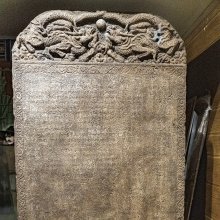Silk cloth: 1 definition
Introduction:
Silk cloth means something in Hinduism, Sanskrit. If you want to know the exact meaning, history, etymology or English translation of this term then check out the descriptions on this page. Add your comment or reference to a book if you want to contribute to this summary article.
Images (photo gallery)
In Hinduism
Pancaratra (worship of Nārāyaṇa)
Source: archive.org: Catalogue of Pancaratra Agama TextsSilk Clothes are typically offered to the icon of the Lord as part of “liturgical worship”, as discussed in chapter 6 of the Sattvata-Samhita: one of the most ancient of Pancaratra Agamas consisting of roughly 3500 verses which stresses the theological standpoint of the oneness of God despite his various vyuhas (modes of existence), vibhavas (manifestations) and avataras (incarnations).—Description of the chapter [sūkṣamavyūha-devatā-bahiryāga-vidhi]: The details of how the liturgy step-by-step is prepared for and how it proceeds are given (7-131). [...] After [bathing the icon, ] the pādapīṭha (foot-rest) is to be set and then wind should be wafted with a fan of peacock feathers; then is offered a comb, followed by offerings of betel nut, flowers, silk clothes, the “sacred thread,” an upper cloth, a crown and all other kinds of ornaments. Again flowers from neck to foot are to be offered along with bangles and pratisara. Then cosmetics are applied to the deity; also betel nut for chewing is given. Two flowers-one over each ear are given, whereupon a mirror is advanced to “show” the deity what has been done (50b-58a).

Pancaratra (पाञ्चरात्र, pāñcarātra) represents a tradition of Hinduism where Narayana is revered and worshipped. Closeley related to Vaishnavism, the Pancaratra literature includes various Agamas and tantras incorporating many Vaishnava philosophies.
See also (Relevant definitions)
Query error!
Full-text (+140): Pitambara, Kausheya, Daukula, Pambari, Kaushambara, Cikatem, Somvalem, Koseyya, Tapata, Daugula, Misalaya, Hemavasana, Accadugula, Koshikara, Musajjara, Sovalem, Madavi, Kalyanapuri, Nimbavali, Neravatte.
Relevant text
Search found 78 books and stories containing Silk cloth, Silk clothes, Silk cloths; (plurals include: Silk cloths, Silk clotheses, Silk clothses). You can also click to the full overview containing English textual excerpts. Below are direct links for the most relevant articles:
Chaitanya Bhagavata (by Bhumipati Dāsa)
Verse 3.10.96 < [Chapter 10 - The Glories of Śrī Puṇḍarīka Vidyānidhi]
Verse 3.5.511 < [Chapter 5 - The Pastimes of Nityānanda]
Verse 2.9.66 < [Chapter 9 - The Lord’s Twenty-One Hour Ecstasy and Descriptions of Śrīdhara and Other Devotees’ Characteristics]
Malatimadhava (study) (by Jintu Moni Dutta)
Part 4 - Dress and Ornaments in the Mālatīmādhava and 8th-century India < [Chapter 4 - Cultural Aspects of the Mālatīmādhava]
Part 6 - Economic Condition in the Mālatīmādhava and 8th-century India < [Chapter 3 - Social Aspects of the Mālatīmādhava]
Harshacharita (socio-cultural Study) (by Mrs. Nandita Sarmah)
15. The style of Costumes < [Chapter 6 - Other Socio-Cultural Aspects]
Part 7: Purdā System < [Chapter 4 - Status of Women]
4. Economic Condition < [Chapter 6 - Other Socio-Cultural Aspects]
Cosmetics, Costumes and Ornaments in Ancient India (by Remadevi. O.)
1. Materials for Garments (b): Silk fibers from Silkworms < [Chapter 2 - Costumes]
1. Materials for Garments (a): Fibers made out of Barks < [Chapter 2 - Costumes]
3.3. Dress Making: Printing and Painting < [Chapter 2 - Costumes]
Skanda Purana (by G. V. Tagare)
Chapter 8 - The Marriage of Śrīnivāsa and Padmāvatī < [Section 1 - Veṅkaṭācala-māhātmya]
Chapter 11 - Dialogue Between Nārada and Indradyumna (Continued) < [Section 2 - Puruṣottama-kṣetra-māhātmya]
Chapter 31 - The Lord in the Wooden Body < [Section 2 - Puruṣottama-kṣetra-māhātmya]
Bhagavata Purana (by G. V. Tagare)
Chapter 75 - Discomfiture of Duryodhana < [Book 10 - Tenth Skandha]
Chapter 45 - Restoration of Preceptor Sāndīpani’s son < [Book 10 - Tenth Skandha]
Chapter 84 - Vasudeva’s Sacrifice < [Book 10 - Tenth Skandha]
